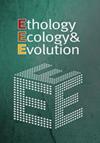性与斑块:生境破碎化对陆生脊椎动物交配策略的影响
IF 1.1
4区 生物学
Q4 BEHAVIORAL SCIENCES
引用次数: 0
摘要
交配系统的概念是指动物在繁殖过程中相互作用的所有策略。动物的社会互动及其交配策略受到景观配置(包括人为栖息地破碎化)的强烈影响。尽管这有可能影响遗传活力和动物行为,但缺乏对其对交配系统影响的最新和全面的审查,因为对潜在过程的详尽理解。因此,我们对生境破碎化对四足动物交配系统和繁殖过程的影响进行了综述。我们强调了文献中存在的不幸偏差(例如,大多数关于鸟类和哺乳动物的研究,没有关于两栖动物的研究),并显示了每一类陆生脊椎动物(即哺乳动物、鸟类和爬行动物)生活在不连续的栖息地可能导致的变化。在零散的栖息地中,资源分布发生了变化;因此,空间占用可能会改变并影响动物的互动方式,导致与连续种群相比,一夫一妻制/一夫多妻制交配系统的潜力变化。我们讨论了在这样的种群中如何分散和间接地改变种群性别比例,并进一步考虑了社会行为的变化,特别是在更小和孤立的斑块中亲缘个体之间的相互作用。鸟类种群中更典型的变化是与交配相关的现象,如配对成功、额外对父权(EPP)率和巢寄生,以及交配策略的转变(如交配行为)。虽然没有发现对生境打包的明确反应,但在文献中出现了一些复杂的和特定于人口的趋势。我们建议采用多学科的方法来实施这方面的研究,特别是评估这种反应的适应性。最后,我们强调在野生动物管理干预措施中考虑行为反应的迫切需要,特别是在处理可能缺乏适应景观退化的可塑性的物种时。本文章由计算机程序翻译,如有差异,请以英文原文为准。
Sex and the patch: the influence of habitat fragmentation on terrestrial vertebrates’ mating strategies
The concept of mating systems refers to all the strategies through which animals interact in the context of breeding. Animal social interactions, and consequently their mating strategies, are strongly influenced by landscape configuration, including anthropogenic habitat fragmentation. Despite this holding the potential to impact both genetic viability and animal behaviour, an updated and comprehensive review on its effects on mating systems is lacking, as an exhaustive understanding of the underlying processes. Thus, we reviewed the literature concerning the influence of habitat fragmentation on mating systems of tetrapods and on processes associated with breeding. We underlined the unfortunate biases present in literature (e.g., most studies on birds and mammals, none on amphibians) and showed the changes possibly led by living in discontinuous habitats for each class of terrestrial vertebrates (i.e., mammals, birds, and reptiles). In fragmented patches of habitats, resource distribution gets altered; consequently, space occupancy may change and affect how animals interact, leading to variable potential for monogamous/polygamous mating systems compared to continuous populations. We discussed how dispersal and indirectly the population sex ratio can be altered in such populations, and further considered changes in social behaviour, specifically in interactions between kin individuals with increasing relatedness in smaller and isolated patches. More typical of bird populations are changes in mating-related phenomena such as pairing success, extra-pair paternity (EPP) rate, and nest parasitism, together with shifts from mating strategies (e.g., lekking behaviour). Although no univocal response to habitat parcelling was found, several complex and population-specific trends emerge in the literature. We suggest a multidisciplinary approach to implement research in this direction, especially to evaluate the adaptive nature of such responses. Ultimately, we underline the urgent need of taking into consideration behavioural responses in wildlife management interventions, particularly when dealing with species that may lack plasticity to adapt to landscape degradation.
求助全文
通过发布文献求助,成功后即可免费获取论文全文。
去求助
来源期刊

Ethology Ecology & Evolution
生物-动物学
CiteScore
3.10
自引率
0.00%
发文量
44
审稿时长
>12 weeks
期刊介绍:
Ethology Ecology & Evolution is an international peer reviewed journal which publishes original research and review articles on all aspects of animal behaviour, ecology and evolution. Articles should emphasise the significance of the research for understanding the function, ecology, evolution or genetics of behaviour. Contributions are also sought on aspects of ethology, ecology, evolution and genetics relevant to conservation.
Research articles may be in the form of full length papers or short research reports. The Editor encourages the submission of short papers containing critical discussion of current issues in all the above areas. Monograph-length manuscripts on topics of major interest, as well as descriptions of new methods are welcome. A Forum, Letters to Editor and Book Reviews are also included. Special Issues are also occasionally published.
 求助内容:
求助内容: 应助结果提醒方式:
应助结果提醒方式:


